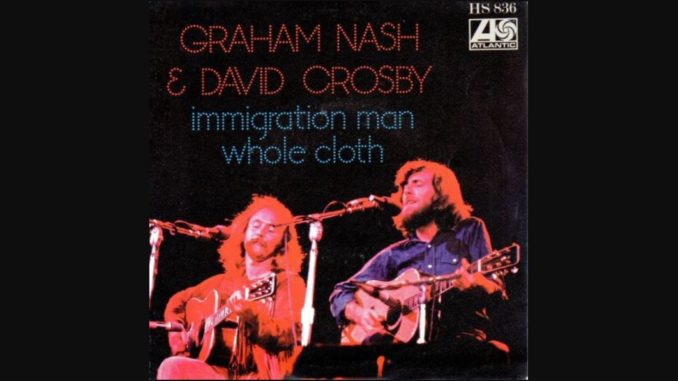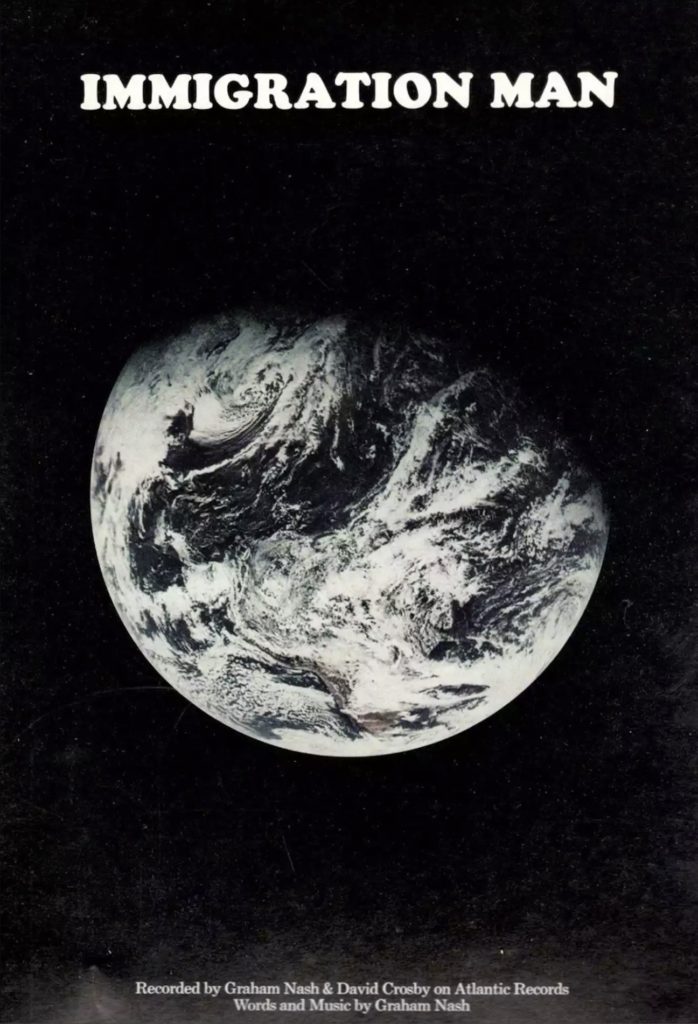
Immigration Man is a song written by Graham Nash, recorded by David Crosby and Graham Nash and released under their joint moniker Crosby & Nash on their first duo album titled Graham Nash David Crosby. Everything crystal clear?
They may have had fun mixing and mashing their names, but those names were very well known at the time. Their main band Crosby, Stills, Nash & Young (CSNY) were after all one of the most successful groups in the land over the past few years. After CSNY took a break at the conclusion of the Deja Vu tour in 1970, all four members would spend 1971 releasing solo albums. They all did very well, reflecting the popularity of their main band. Crosby released If I Could Only Remember My Name and Nash Songs for Beginners, both which were certified gold records by the RIAA.
The two of them had always been friends and certainly at that time seemed to have a less complex relationship than anyone else in CSNY. In the autumn of 1971, the duo was happy to embark on a series of concerts together, and wanting to keep it simple they never really considered including Stills and/or Young.
Reviews were very favourable, with good vibes between the two frontmen, who not only performed well but shared in amusing anecdotes and humorous banter which contributed to the success of the shows. One night from this tour would be released 27 years later as Another Stoney Evening.
Several new songs would slip into the setlists as they went along, and a desire to record these tracks led Crosby and Nash into the recording studio after the tour.
One of the songs in their arsenal was Immigration Man. Nash had written it about an unfortunate encounter with a U.S. Customs official when he tried to re-enter the country.
It happened in 1970. CSNY had been playing a string of shows in Canada and were looking to travel back to the US. Nash was still an English citizen at the time – he would get his American citizenship in 1978, but for the time being, there was still some extra work to do to get Visas and all needed documents in order. But, this was not a problem. Nash, of all people, always had his paperwork in order. But, someone decided he was suspicious.
David Crosby and Graham Nash were interviewed on separate occasions by Joe Pascal at the Hudson Union Society, and in being a fan about the song, he asked both of them about it.
“I’ve said it before, to write a song I have to feel,” Nash said. “And if you piss me off, I’m feeling shit, you know?”
Crosby said, “He was ticked off. He’s a Brit, and he expect things to work. We were coming back from Canada, and of course, Neil and Stephen and I were the real troublemakers, but we got in no problem. We had passports. But they stopped Graham, and some officious twit didn’t like Graham, or didn’t like his attitude, or something, and he hung him up for quite a while, and he shouldn’t have done that.”
Nash sets the scene: “It’s 1970. CSNY played a show at Vancouver, I think, in British Columbia. The show was good, and then we get to the airport to fly back to our homes, and they let David and Stephen and Neil in, and not me. I had only been in the country for about a year and a half in 1970/71, and I was on this H1 Visa. You’d have to go to the American Embassy in Drogher Square in London and wait in line for hours to get a Visa to come here. Then there was some weird musician’s union rule that you had to prove that nobody here could make music like you before they would let you in. I don’t know who judges that shit. He gave me a run-around for a few hours. Checking Visas, calling lawyers and stuff. I don’t like to be left out. I don’t know if you are the same as me, but I don’t like to be left out. I’m a band member, I like friends, but this was really isolating me and making me feel not welcome, which is not what I had experienced in America. So I’m furious, you know. The guy’s pissing me off. It was obvious [that I was who I said I was], easily… I mean, there’s people asking me for autographs… it was an insanity. On the plane home I was thinking about it and thinking some more about it, and I got into my house in San Francisco and wrote Immigration Man.”
Crosby: “It was totally unnecessary. We had all the papers, and Graham is a gentleman and a very civilized person, as you know. And it ticked him off. And you know… you really shouldn’t do that with Graham. Because he’ll write a song about it. And he did! We do that. He did it really well, and I like that song. I liked that one as it came right from the heart, and I kind of like it when he gets mad.“
There I was at the immigration scene
Shining and feeling clean
Could it be a sin?
I got stopped by the immigration man
He says he doesn’t know if he can let me in
Let me in immigration man
Can I cross the line and pray
I can stay another day
Let me in immigration man
I won’t toe your line today
I can’t see it anyway
There he was with his immigration face
Giving me a paper chase
But the sun was coming
Cos all at once he looked into my space
And stamped a number over my face
And he sent me running
Everything that happened is matter-of-factly retold in the song. In the first verse, Nash is going through customs when he is stopped and held back. The second verse details how Nash was given trouble over various documents, and the third finds him filling out a form that Nash humorously describes to be as big as a blanket (“Here I am with my immigration form / It’s big enough to keep me warm when a cold wind’s coming”).
Crosby joins Nash on vocals in every chorus, as well as in the final verse which offers a warning to travellers worldwide (“So go where you will as long as you think you can / You better watch out for the man anywhere you’re going”).
Towards the end of the song, Nash adds the variation “Let me in, irritation man” in the final chorus, which is the only time in the song he reveals, albeit in an extremely understated way, how he really felt about the official and the whole episode.
Nash usually tells a bit of this story when he introduces the song live. In 2015, when performing it with a choir and orchestra in Cleveland OH, he said “In the early 70s, me and David and Stephen and Neil were doing a show in Vancouver. I hadn’t become an American citizen at that point. I have been for decades now, but at that point I wasn’t. We got to the customs, and they let David through. They let Stephen through. They even let Neil through. Me? No. They grilled me for at least an hour and a half about why I was there. And while they were grilling me, people were coming up to me and asking me for my autograph. And I couldn’t explain to the guy, because I’m not one of those, ‘don’t you know who I am?’ Anyway, I was furious, got on a plane, went back to my house in San Francisco and wrote Immigration Man.”
The song was an obvious candidate for the album they set out to make back in 1972. Nash sang lead and played piano on this track, with Crosby on acoustic guitar and harmony vocals. The lead guitarist is Dave Mason, who has played on more of your favourite records from the 1960s, 70s, and 80s than you’re aware. The other musicians are John Barbata on drums and Greg Reeves on bass.
While the song’s backstory becomes a dominating factor of it, the song’s overall sound is also very important. Whereas most of the songs on the album are acoustic-based and on the mellow side, Immigration man is more rousing with an electric arrangement and a bigger sense of things going on, which frankly is the way to go given the topic. The harmonies in the song also stand out as powerful, making this the song that comes closest to CSNY in that regard.
In the liner notes to the CSN boxed set, Nash talks about the arrogance of the official which still ticks him off: “I wrote the song after being hassled by a customs official who wasn’t going to let me into this country. He held me up for a very long time. Then people started coming up, asking for my autograph, and he let me through immediately. But it still made me angry. I’m not against local color but why should you fight me because you speak differently than I do?”

Nash chose a picture of the earth seen from space for the cover of the song’s sheet music. “I would really have loved the perspective of the astronauts. To stand on the fucking moon and look back at the Earth — how beautiful, right? But when you see the first photograph of the Earth Rise, there’s no boundaries. There’s no borders. There’s no fucking walls. There’s just this blue marble in space.“
He added, “It’s really funny because a lot of people think that space is out there, but as we’re eating our lunch, we’re in space. So that’s why I put that photo on the sheet music. I wanted people to know. How many countries are in the world now? No, no, it’s just one planet!”
The Graham Nash David Crosby album was released on 5 April 1972, with Immigration Man released as its lead single in March. It peaked at #36 on the Billboard Hot 100, and is their only Top 40 hit as a duo. The album fared better, making it all the way to #4 of the US Billboard LP chart. It did well elsewhere too, including a Dutch #4, Canadian #6, UK #13, Australian #18, and just missing out on the top 10 in the Norselands with #11 in both Norway and Sweden.
The commercial success of this album equalled, and even surpassed a bit, that of the pair’s two solo albums of the previous year, although it would not be until after the second break-up of CSNY following their 1974 summer tour that Crosby and Nash would sign an album contract as a unit with ABC Records and release further albums as a duo.
Following the release of this album, they toured in 1973 with a backing band including, at different times, David Lindley and future Eagles guitarist Don Felder.
The success of the album and tour demonstrated that the two were still a viable draw without the more successful Stills and Young.

Facebook Comments